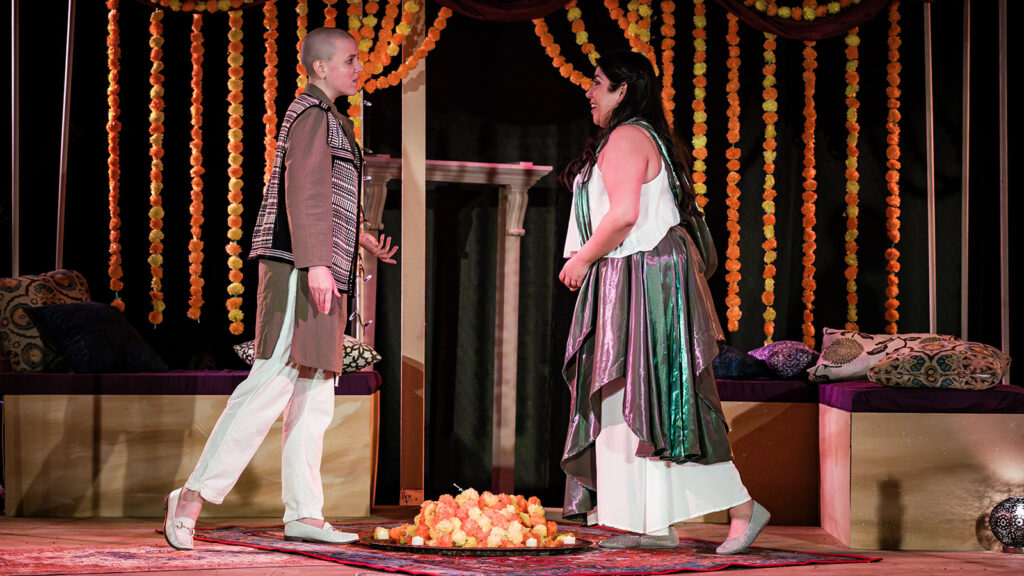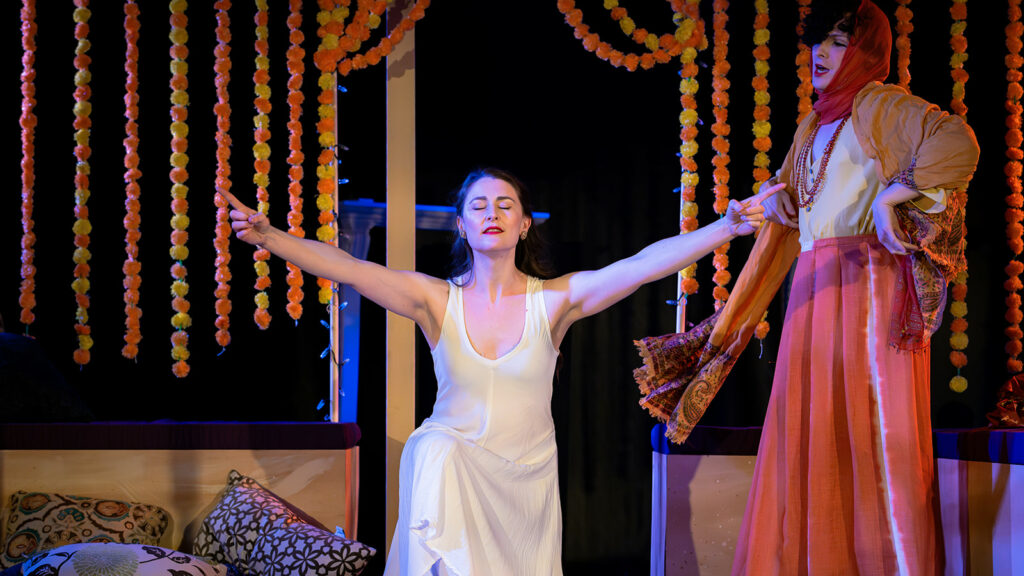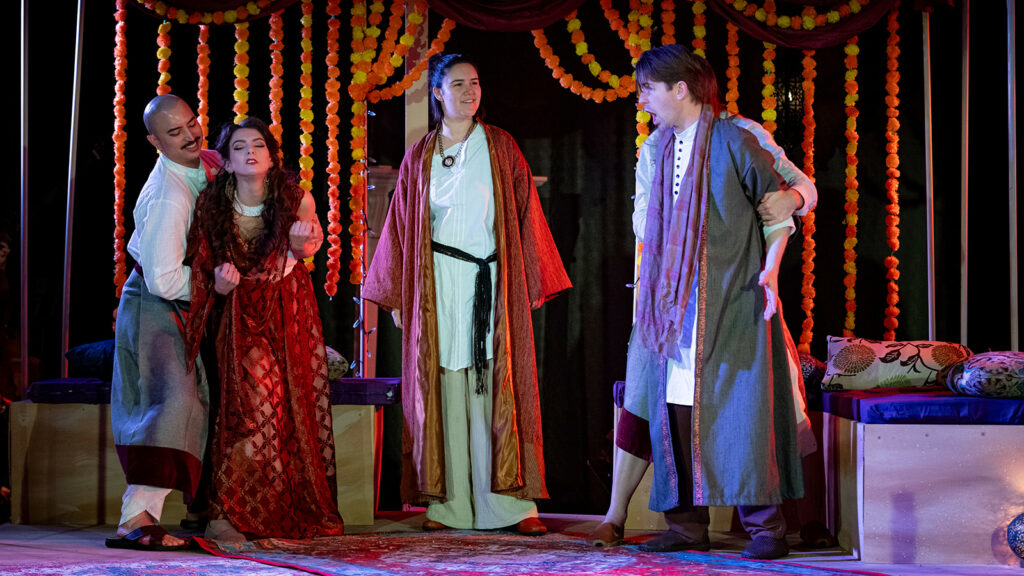
Bayou Elom
Styled as Poppea, the IN Series production did not fully cohere but was buoyed by the high caliber of its cast. In recent seasons, IN Series has offered remixed versions of Monteverdi’s operas, including a L’Orfeo inspired by the Japanese Noh tradition and a Vietnam War-era Il ritorno d’Ulisse in patria. The company wrapped up this ambitious project with this month’s mounting of Poppea, presented in Washington, DC and Baltimore, MD. IN Series offered DMV opera fans the rare opportunity to see a staged production of this large-scale work by the composer considered to be the father of the art form.
IN Series artistic director Timothy Nelson served as stage and music director for this Poppea inspired by artistic traditions of India. IN Series performed the opera with an English translation of Giovanni Francesco Busenello’s libretto that incorporated Indian poetry. Ami Dang and Rajna Swaminathan composed new music for the opera, which survives only in two incomplete manuscripts which gives modern performers creative liberty in reconstructing it. The pluck of the sitar, played by Dang, and the pulse of the mridangam, an Indian drum played by Swaminathan, provided an engaging dialogue with IN Series’ Baroque music ensemble, led by Nelson on harpsichord.

Bayou Elom
Nelson set a brisk pace (as brisk as Monteverdi’s rather sprawling opera can be) and effectively kept time with the legions of characters who appear over Poppea’s cascade of scenes. Nelson interspersed five sequences of Bharatanatyam dance choreographed by Hari Krishnan and masterfully performed by Yasseen Hassan, Tenesha Hunter, and Chitra Subramanian. While engrossing, these abstract interludes generally did little to advance the plot or themes of the opera, with the exception of a swirling dance representative of Seneca’s state of mind preceding his suicide. The addition of the dances lengthened the production, which ran over three hours, and it wasn’t entirely clear what role they were intended to play.
The highlight of the performance was the pairing of Canadian soprano Caitlin Wood as Poppea and IN Series veteran Aryssa Burrs as Nerone. Wood’s warm and rich soprano made her a persuasive Poppea, ambitious but tender and teasing in her scenes with Burrs, making it easy to understand how she caught the eye of the emperor of Rome. Burrs’s bright, silvery mezzo-soprano was a natural fit for the confident and commanding ruler. The pair’s divine chemistry made for standout duets, including a captivating rendition of the characters’ final number. This production marked Wood’s US debut, and American opera-goers can only hope that her career will continue to grow on this side of the border.

Bayou Elom
Bass Peter Walker’s booming, flinty tone and crisp intonation lent dignity to the beleaguered philosopher Seneca, whose suicide, ordered by Nerone, removes a key obstacle to the emperor’s plan to replace his wife, Empress Ottavia, with Poppea. Daniel Moody’s strong, smooth countertenor made for an enthralling performance as Ottone, Poppea’s former lover cast aside in favor of the emperor. Rounding out the principal roles, soprano Maribeth Diggle gave an emotional portrayal of the rejected Ottavia’s descent through the stages of grief, but her thunderous delivery felt out of step with the opera’s Baroque idiom.
Among the rest of the large cast, Elijah McCormack’s creamy, dream-like soprano countertenor made him a triumphal Amore and a magnetic Valetto, alternatively gleeful when defending his mistress Ottavia from Seneca’s stoicism and enchanting in the character’s aria of first love, deftly reciprocated by soprano Judy Yannini’s Damigella.

Bayou Elom
Soprano Dawna Rae Warren gave a radiant take on Drusilla, Ottone’s initially naive admirer who later sacrifices herself to save him. Countertenor Hunter Shafer, an IN Series favorite, skillfully shouldered many of the production’s humorous elements as Poppea’s nurse Arnalta and gave a joyfully memorable final act aria. The humor of this Poppea, from the gossipy tea-spilling soldiers of Act I to the comedic antics of the nurses, jarred with the production’s dark, BDSM portrayal of Nerone’s extracurricular activities. These included wax play (is there such a thing as a Chekhov’s candle?) and sadistic murder (rest in peace, Nerone’s friend Lucano). Between the opposing efforts to be both humorous and edgy, the production ultimately lacked some cohesion.
IN Series’s production was most effective when it cleverly wove in elements of Indian wedding traditions, a perfect fit for this opera that hinges on matrimony. The stage, a creation of set designer Kathryn Kawecki, took the form of a cushioned and shaded pavilion. Lighting from Paul Callahan effectively shifted the tenor from scene to scene. The back of the set was bedecked with floral garlands reminiscent of an Indian marriage ceremony, thoughtfully foreshadowing Poppea’s eventual nuptial victory. Nelson’s blocking had couples moving in circular formations that recalled Saptapadi, the Hindu wedding practice of circumambulating a fire seven times to indicate an unbreakable commitment. This production caps off IN Series’s own impressive commitment to staging Monteverdi’s three major surviving operas, and I look forward to what the company chooses to take on next.





Comments